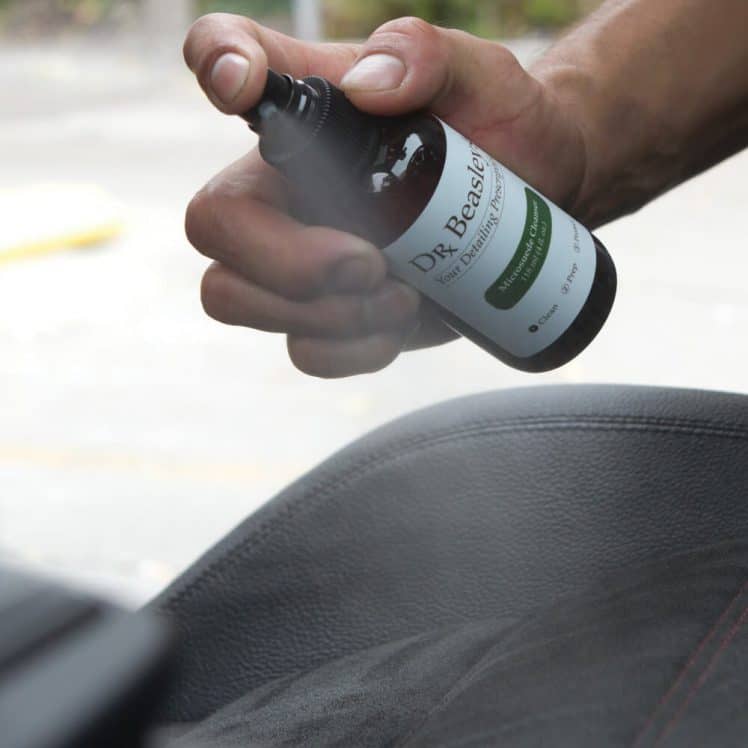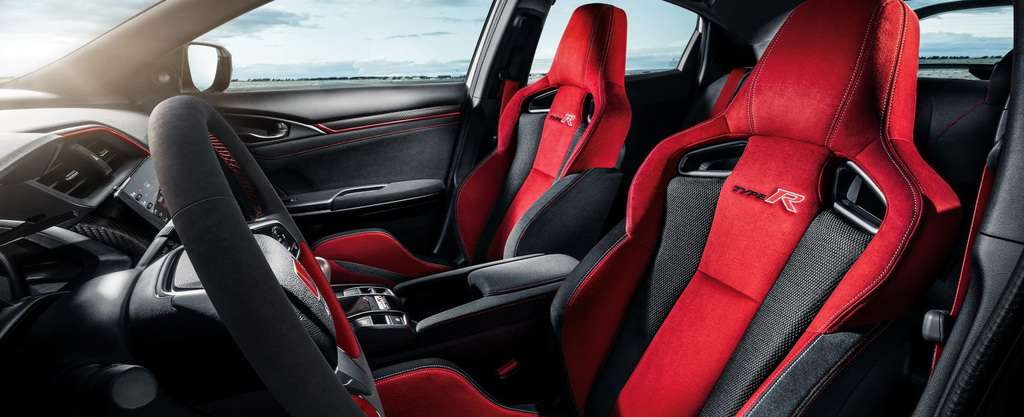Most people may not be quick to admit it, but the velvety soft sensation of suede upholstery beneath your fingertips borders on the sublime. However, for as real as it may feel, that’s probably not genuine leather you are fawning over, but a faux suede alternative. Commonly referred to as “Microsuede,” this generically labeled product can be found almost anywhere real leather or suede might reside, with the most recognizable brands being Alcantara, Ultrasuede, and Dinamica.
Over the course of the past sixty years, Ultrasuede and Alcantara in particular have taken the world of upholstery and fabrics by storm. Packing superior softness, greater durability, lower manufacturing costs, more sustainable environmental footprints, and milder interior cleaner migraines, this dynamic duo spanks animal-based leather and suede ass on a multitude of levels.
In recent years, these man-made materials have seen a rise in popularity with automakers, as auto manufacturers look for affordable and sustainable ways to add soft-touch materials to steering wheels, seats, and shift knobs. But even Ultrasuede and Alcantara can get filthy over time, and without properly executed cleaning procedures, can become crusty, faded, stained, thread-bare, and discolored.
So is there a good way to clean Microsuede products like Ultrasuede and Alcantara? And if so, what products work best when it comes to scrubbing and protecting this microfiber fabric?
What is Microsuede? A Super Soft History Lesson
As we briefly discussed in our feature focusing on properly cleaning microfiber cloths, the microsuede and Alcantara leather saga began in the 1950s, when a race to create a soft, suede-like synthetic material jumped off the starting line. But try as they might, scientists and manufacturing moguls alike were unable to create a cost-effective synthetic cloth that felt and looked like real suede. And while the race to creating a super soft man-made substance began in the 1950s, it would take almost two decades for a synthetic fiber winner to emerge.
The year was 1970, and Japanese scientist, Miyoshi Okamoto, had just announced that he had created a man-made material the likes of which the world had never seen before. While working on an unmonitored side project at Japan’s Toray Industries, Okamoto had developed a way to engineer the world’s first strand of microfiber. A microscopic material packing a polymer so tiny, that it was invisible to the naked eye. That said, for as outstanding as this breakthrough may have been at the time, this single strand was a far cry from being labeled as useful.

It was not until later, when Okamoto’s colleague, Toyohiko Hikota, came up with a way to process this fiber in such a way that it created a non-woven fabric, that things would really begin to get interesting. Hikota found that once extruded, the microfiber could be ironed, curled, cut, and affixed to a rope-like lining called a “scrim” via needlepoint.
It was this scrim that would provide the tautness and durability that the scientists had so desperately sought. Once injected with a binding agent, and topped with a special solvent designed for dissolving the top polymer layer, Hikota’s experiment became equal parts soft and durable, all while looking and feeling like real suede.
Once assembled, this revolutionary piece of fabric became a super soft, stain resistant, washable, breathable fabric. It was also less expensive to manufacture than its animal hide alternative, and could easily be dyed any color without the risk of premature fading. Needless to say, the Toray team was elated beyond words, and after much discussion, opted to name its versatile textile “Ultrasuede.”
“The most innovative material since the fig leaves worn by Adam and Eve.”
-TIME MAGAZINE
However, despite its revolutionary benefits over organic leather and suede, there was a fear that people would be skeptical of the Japanese invention, preferring the real thing in its stead. Faux suede was running the risk of never catching on, and the future was uncertain for the Toray team’s brilliant invention.
Never one to give-up on a good idea, Toray Industries began building hype for a product codenamed “L-223” that manufacturers and designers alike could love. Later that year, during the fall/winter Paris haute couture collections event, Ultrasuede made its major fashion debut, and things began to steamroll.
Ultrasuede’s affordable price point, coupled with its simple cleaning requirements, undeniable durability, and authentic suede-like texture, all made for a very appealing sales pitch. Almost overnight, the faux suede material went from being skeptically viewed as a cheap knock-off, to being heralded as a “new skin made for mankind.”

Are Ultrasuede and Alcantara the Same Thing?
It was not until 1972, when Toray Industries ventured back over to Europe, that Ultrasuede’s “Alcantara” Italian twin would emerge onto the scene. Produced and marketed in collaboration with Italy-based ENI Group, Alcantara was identical to the Japanese original, all save for its fancy Italian title.
Thanks to this rebranded nameplate, Alcantara was able to gain recognition across the European continent as an upholstery and fashion marvel, even after Ultrasuede had made its splash just just two years prior. As sales slowly but surely shifted into high gear with each passing year, Alcantara’s move toward the automotive sector seemed all but imminent, and Toray Industries could not have been more thrilled.
What began with furniture and fashion, officially trickled into the European automaker market with the introduction of the Fiat X 1/9 in 1978, which sported the rebranded synthetic fiber on key interior components. This was followed by some 1980s Lancia love, various contracts with companies like Audi, and a plethora of clothing and fashion advancements in the 1990s, which once coupled with microsuede seating, surely produced a shit-ton of car seat static.
However, it would not be until November of 1999, when a high-performance product geared toward automotive interiors was developed, that microsuede would truly begin to hone-in on the automotive sector. The 2000s brought with it the introduction of this man-made material to the mainstream, when Toyota opted to slap the suede alternative into higher trim versions of its venerable Camry commuter car. Today, the recently refreshed FK8 Honda Civic Type R holds the title as the Alcantara poster child of modern automobiles, with swaths of interior touches on the hot hatch being clad in the plush fabric.
Quick Nerd Note: According to a report by Hemmings, there are around 250 patents protecting Ultrasuede/Alcantara. These patents encompass everything from production and extrusion processing, to the forms of spinnerets and needle punches used, and onward to the dyeing process. Their ability to resist interior damage caused by spills, scuffs, and sunlight are unlike anything else out there, turning a fabric that millions of drivers take for granted each day into one of the world’s most heavily guarded trade secrets.

Photo Credit: Dodge
Benefits of Ultrasuede and Alcantara
Microsuede is typically offered as a leather/suede alternative on automotive interior components due to its pleasant texture, imperviousness to extreme temps, durability, and ease of cleaning. Skin doesn’t stick to microsuede like it does to leather, and it feels cool in summer and warm in winter, making it an ideal option for bare skin contact points like steering wheels, seats, and shift knobs. Both Ultrasuede and Alcantara are also more water resistant than animal hide-based suede.
Microsuede is also about 50% lighter than traditional suede, is far more rip resistant, and is not nearly as prone to sun fade, a huge help for those who abhor this common used car detailing debacle. The stuff is also easy to grasp, giving one more reason for its application on things like steering wheels and shifters.
Oh, and being that this is a man-made material, microsuede is always a cruelty-free product, and is far less detrimental to the environment due to not being a livestock-dependent product. As more automakers, furniture manufacturers, and clothing companies gravitate toward more sustainable suede alternatives, Toray Industries’ manufacturing of Ultrasuede and Alcantara continues to prosper.
Quick Nerd Note: According to Toray Industries, since 2010, Ultrasuede’s furniture, automobile upholstery, and fashion segments have all relied upon advanced recycling technologies. This means that newer generations of Ultrasuede and Alcantara are all being made with plant-based polyesters found within biodegradable waste and natural byproducts recovered from food-processing plants.

Cleaning Products That You Should Never Use On Microsuede
Before we get into talking about what works best for cleaning microsuede, we should first focus on what to avoid, starting with alcohol. While an Isopropyl Alcohol blend may be ideal for prepping the surface of an automobile ahead of a ceramic coating DIY session, it dries the ever-loving hell out of microsuede fibers. So keep that alcohol away from your Alcantara and Ultrasuede. And while vinegar will remove foul smells, it won’t lift dirt or remove stains from microsuede, so this cleaning staple gets the axe as well.
Since concentrated heat can quickly damage microsuede, steam cleaning should always be avoided. If allowed to overheat, microsuede turns dry and hard, at which point reviving it becomes damn near impossible. So look toward other cleaning options in order to keep that synthetic fabric under 140° Fahrenheit.
Cool water, on the other hand, tends to oversaturate microsuede surfaces, which if left to permeate for prolonged periods of time, can permanently stain surface follicles. Being that microsuede is super absorbent, mildew formation is also a concern when excessive water is present, so always try and keep things dry when in contact with Alcantara leather or Ultrasuede.
Finally, we turn toward the omnipresent all-purpose cleaner. While an all-purpose cleaner may be great for most surfaces, many of the chemicals encapsulated within these products are quick to change the texture and color of microsuede, which can in turn lead to permanent staining.

So What Tools and Chemicals Clean Microsuede Best?
The best way to clean Alcantara or Ultrasuede the right way, is to spend the cash, and purchase a specialized microsuede cleaning chemical and a soft bristle upholstery brush. No need for fancy cleaning tools or additional conditioners, just an old fashioned one-two punch, and a little bit of elbow grease is all that’s required to restore microsuede.
While there are a handful of well-received synthetic suede cleaning products on the market, Dr. Beasley’s Microsuede Cleanser is without question a frontrunner in regard to positive reviews and pricing. From food and drink debris, to body oils, coffee stains, dirt, pet urine, and vomit, this stuff lifts it right off with little more than a spritz and a soft brush or microfiber cloth. Body oils are particularly good at dirtying man-made suede too, which if left unattended, can become hard in texture and visually unappealing. So even if there isn’t a spill in your car, chances are that microsuede is still getting a bit haggard.
As for heavier stains caused by things like pen ink, makeup, and blood, the need for stronger products becomes apparent, at which point it would be wise to opt for Dr. Beasley’s Microsuede Spot Remover. Applying a microsuede protectant afterward is never a bad idea either, especially since Armor Shield IX is not designed for soft surfaces.
As for selecting the ideal soft bristle brush, there are more options out there than we can count. Review-wise, the overall winner seems to be the TriNova soft bristle brush, which is designed for leather and upholstery alike. This scrubber is soft enough that it will not damage materials like Ultrasuede and Alcantara, while still remaining rigid enough to dislodge dirt and safely scrubbing between tightly stitched surfaces. Our only word of caution here is that even with a soft bristle brush, you should never use too much pressure when brushing microsuede, because you could permanently damage the material.
Quick Nerd Note: According to a brief history of Alcantara by Road & Track, Ultrasuede and Alcantara primarily consist of a custom blend of heavily textured, recycled and biomass-derived polyester and polyurethane polymers. While we’d love to tell you more about the genetic makeup of these intricately woven polymers, as we previously mentioned, much of Toray’s microsuede manufacturing remains shrouded in secrecy.

Cleaning Microsuede the Right Way
In order to properly clean microsuede, you must first have the aforementioned car cleaning chemicals and tools (or something like them), and remember to be gentle with your scrubbing. Gently brush the microsuede fibers one direction, and then follow your stroke with a spritz of approved cleaning product, being careful to not oversaturate the surface. After allowing the fibers to dry for a few minutes, pull the brush across the microsuede in the opposite direction from which it was just pushed. Spray again, and then repeat these steps from a different direction until the surface looks clean. Gently vacuum as necessary.
Once cleaned, reach for that bottle of microsuede protector, as its hydrophobic properties will cause liquids to bead-up and roll away, while repelling dirt and oils as well. Properly cleaned and treated, your microsuede will look and feel as good as new. Just remember to clean regularly, and neutralize spills and stains right after they occur, because unlike floor liners and traditional upholstery fabrics, the all-in-one spray and pray approach will likely do more harm than good.












